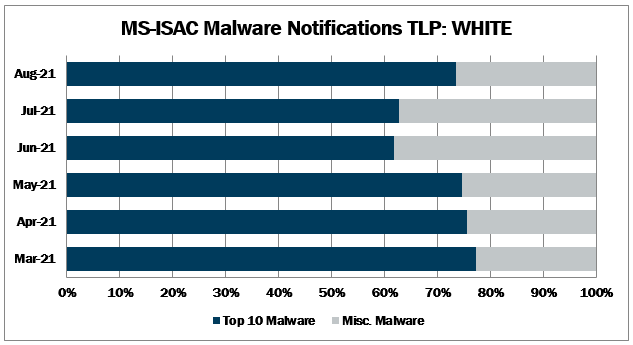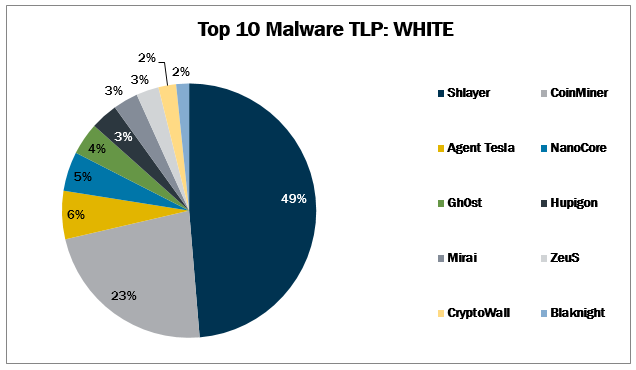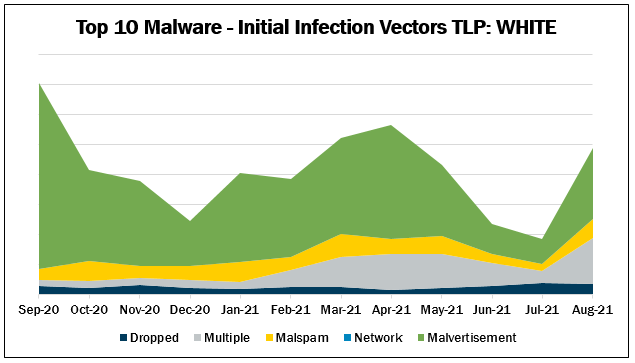Top 10 Malware August 2021



Dropped – Malware delivered by other malware already on the system, an exploit kit, infected third-party software, or manually by a cyber threat actor. Gh0st and Mirai are examples of this vector.
Multiple – Malware that currently favors at least two vectors. Currently, CoinMiner, CryptoWall, Hupigon, and ZeuS are malware utilizing multiple vectors.
Malspam – Unsolicited emails, which either direct users to malicious web sites or trick users into downloading or opening malware. Top 10 Malware using this technique include Agent Tesla, Blaknight, and NanoCore.
Malvertisement – Malware introduced through malicious advertisements. Currently, Shlayer is the only Top 10 Malware using this technique.
Top 10 Malware and IOCs
Below are the Top 10 Malware ranked in order of prevalence. The respective indicators of compromise (IOCs) are provided to aid in detecting and preventing infections from these Top 10 Malware variants. Note: The associated URIs are aligned with malware’s respective domain(s) or IP(s) and increase the likelihood of maliciousness when found together. The URIs alone are not inherently malicious.
1. Shlayer
Shlayer is a downloader and dropper for MacOS malware. It is primarily distributed through malicious websites, hijacked domains, and malvertizing posing as a fake Adobe Flash updater.
All Shlayer domains follow the same pattern
Domains
- api[.]interfacecache[.]com
- api[.]scalableunit[.]com
- api[.]typicalconfig[.]com
- api[.]standartanalog[.]com
- api[.]fieldenumerator[.]com
- api[.]practicalsprint[.]com
- api[.]searchwebsvc[.]com
- api[.]connectedtask[.]com
- api[.]navigationbuffer[.]com
- api[.]windowtask[.]com
2. CoinMiner
CoinMiner is a cryptocurrency miner that uses Windows Management Instrumentation (WMI) and EternalBlue to spread across a network. CoinMiner uses the WMI Standard Event Consumer scripting to execute scripts for persistence. CoinMiner spreads through malspam or is dropped by other malware.
3. Agent Tesla
Agent Tesla is a RAT that exfiltrates credentials, logs keystrokes, and captures screenshots from an infected computer.
4. NanoCore
NanoCore is a RAT spread via malspam as a malicious Excel XLS spreadsheet. As a RAT, NanoCore can accept commands to download and execute files, visit websites, and add registry keys for persistence.
5. Gh0st
Gh0st is a RAT used to control infected endpoints. Gh0st is dropped by other malware to create a backdoor into a device that allows an attacker to fully control the infected device.
6. Hupigon
Hupigon is a backdoor trojan that is usually dropped by other malware or is unknowingly downloaded via a malicious website. Some of this malware’s abilities include: allowing remote users to connect to the affected system and execute commands on the system, logging keystrokes, and stealing information, such as credentials.
7. Mirai
Mirai is a malware botnet known to compromise internet of things (IoT) devices in order to conduct large-scale DDoS attacks. Mirai is dropped after an exploit has allowed the attacker to gain access to a machine.
8. Zeus
ZeuS is a modular banking trojan which uses keystroke logging to compromise victim credentials when the user visits a banking website. Since the release of the ZeuS source code in 2011, many other malware variants have adopted parts of its codebase, which means that events classified as ZeuS may actually be other malware using parts of the ZeuS code.
9. CryptoWall
CryptoWall is a ransomware commonly distributed through malspam with malicious ZIP attachments, Java Vulnerabilities, and malicious advertisements. Upon successful infection, CryptoWall will scan the system for drive letters, network shares, and removable drives. CryptoWall runs on both 32-bit and 64-bit systems.
10. Blaknight
Blaknight, also known as HawkEye, is an Infostealer known for its keylogging capabilities for credential and banking theft.
![]()
As of June 23, 2025, the MS-ISAC has introduced a fee-based membership. Any potential reference to no-cost MS-ISAC services no longer applies.